Zhou Liu
A Two-Stage Lightweight Framework for Efficient Land-Air Bimodal Robot Autonomous Navigation
Jul 30, 2025Abstract:Land-air bimodal robots (LABR) are gaining attention for autonomous navigation, combining high mobility from aerial vehicles with long endurance from ground vehicles. However, existing LABR navigation methods are limited by suboptimal trajectories from mapping-based approaches and the excessive computational demands of learning-based methods. To address this, we propose a two-stage lightweight framework that integrates global key points prediction with local trajectory refinement to generate efficient and reachable trajectories. In the first stage, the Global Key points Prediction Network (GKPN) was used to generate a hybrid land-air keypoint path. The GKPN includes a Sobel Perception Network (SPN) for improved obstacle detection and a Lightweight Attention Planning Network (LAPN) to improves predictive ability by capturing contextual information. In the second stage, the global path is segmented based on predicted key points and refined using a mapping-based planner to create smooth, collision-free trajectories. Experiments conducted on our LABR platform show that our framework reduces network parameters by 14\% and energy consumption during land-air transitions by 35\% compared to existing approaches. The framework achieves real-time navigation without GPU acceleration and enables zero-shot transfer from simulation to reality during
Object Isolated Attention for Consistent Story Visualization
Mar 30, 2025Abstract:Open-ended story visualization is a challenging task that involves generating coherent image sequences from a given storyline. One of the main difficulties is maintaining character consistency while creating natural and contextually fitting scenes--an area where many existing methods struggle. In this paper, we propose an enhanced Transformer module that uses separate self attention and cross attention mechanisms, leveraging prior knowledge from pre-trained diffusion models to ensure logical scene creation. The isolated self attention mechanism improves character consistency by refining attention maps to reduce focus on irrelevant areas and highlight key features of the same character. Meanwhile, the isolated cross attention mechanism independently processes each character's features, avoiding feature fusion and further strengthening consistency. Notably, our method is training-free, allowing the continuous generation of new characters and storylines without re-tuning. Both qualitative and quantitative evaluations show that our approach outperforms current methods, demonstrating its effectiveness.
UniSync: A Unified Framework for Audio-Visual Synchronization
Mar 20, 2025Abstract:Precise audio-visual synchronization in speech videos is crucial for content quality and viewer comprehension. Existing methods have made significant strides in addressing this challenge through rule-based approaches and end-to-end learning techniques. However, these methods often rely on limited audio-visual representations and suboptimal learning strategies, potentially constraining their effectiveness in more complex scenarios. To address these limitations, we present UniSync, a novel approach for evaluating audio-visual synchronization using embedding similarities. UniSync offers broad compatibility with various audio representations (e.g., Mel spectrograms, HuBERT) and visual representations (e.g., RGB images, face parsing maps, facial landmarks, 3DMM), effectively handling their significant dimensional differences. We enhance the contrastive learning framework with a margin-based loss component and cross-speaker unsynchronized pairs, improving discriminative capabilities. UniSync outperforms existing methods on standard datasets and demonstrates versatility across diverse audio-visual representations. Its integration into talking face generation frameworks enhances synchronization quality in both natural and AI-generated content.
A Review of Human Emotion Synthesis Based on Generative Technology
Dec 10, 2024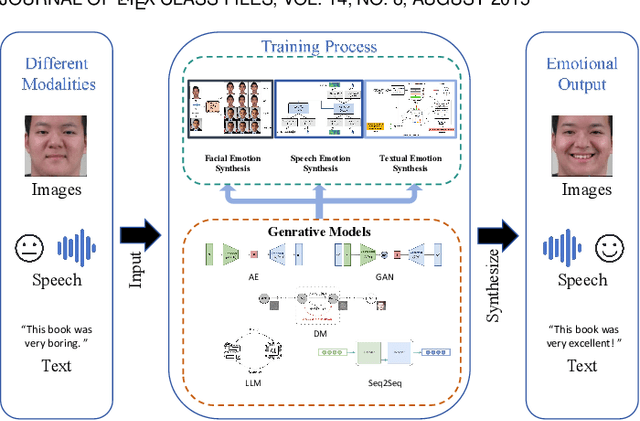
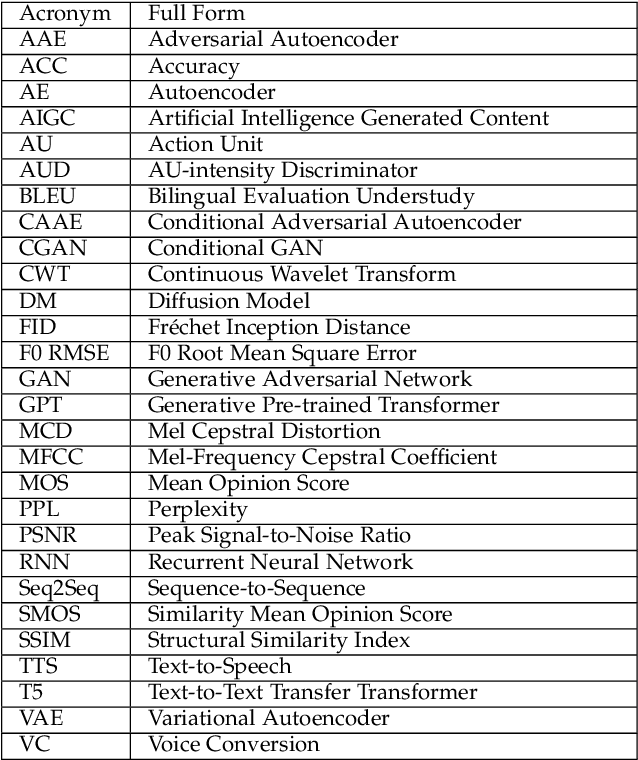
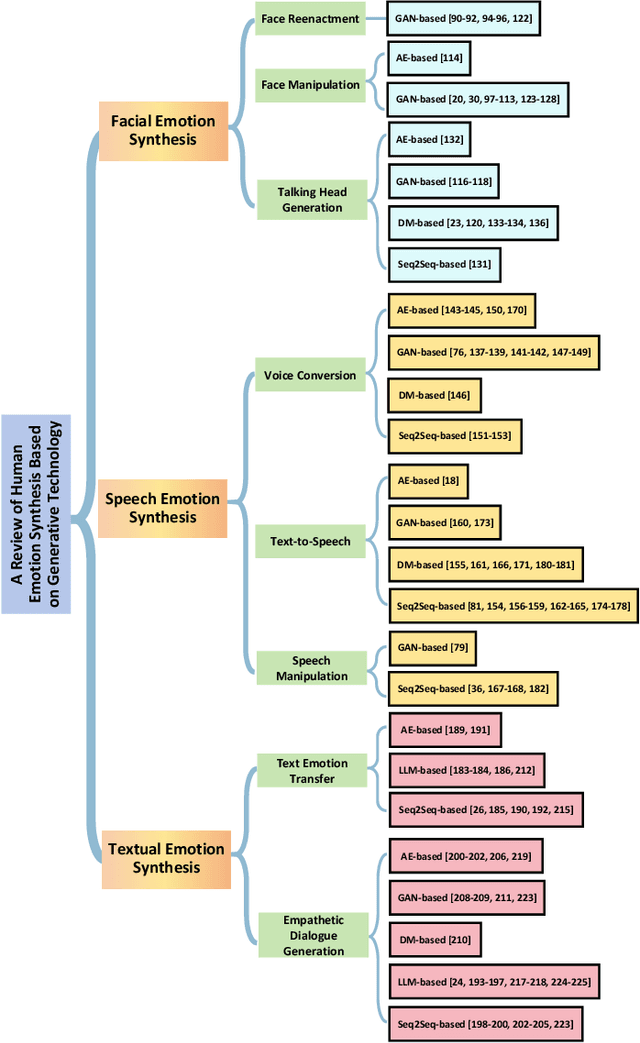

Abstract:Human emotion synthesis is a crucial aspect of affective computing. It involves using computational methods to mimic and convey human emotions through various modalities, with the goal of enabling more natural and effective human-computer interactions. Recent advancements in generative models, such as Autoencoders, Generative Adversarial Networks, Diffusion Models, Large Language Models, and Sequence-to-Sequence Models, have significantly contributed to the development of this field. However, there is a notable lack of comprehensive reviews in this field. To address this problem, this paper aims to address this gap by providing a thorough and systematic overview of recent advancements in human emotion synthesis based on generative models. Specifically, this review will first present the review methodology, the emotion models involved, the mathematical principles of generative models, and the datasets used. Then, the review covers the application of different generative models to emotion synthesis based on a variety of modalities, including facial images, speech, and text. It also examines mainstream evaluation metrics. Additionally, the review presents some major findings and suggests future research directions, providing a comprehensive understanding of the role of generative technology in the nuanced domain of emotion synthesis.
BS-Diff: Effective Bone Suppression Using Conditional Diffusion Models from Chest X-Ray Images
Nov 26, 2023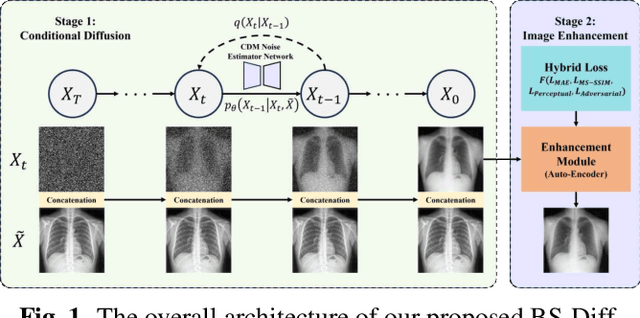
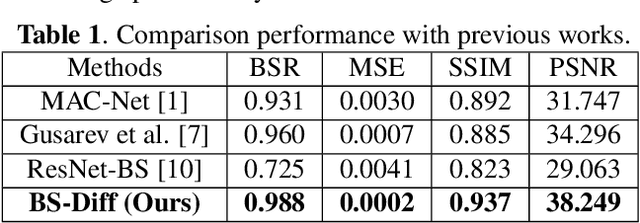
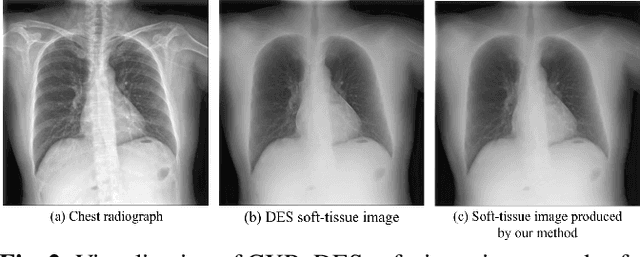
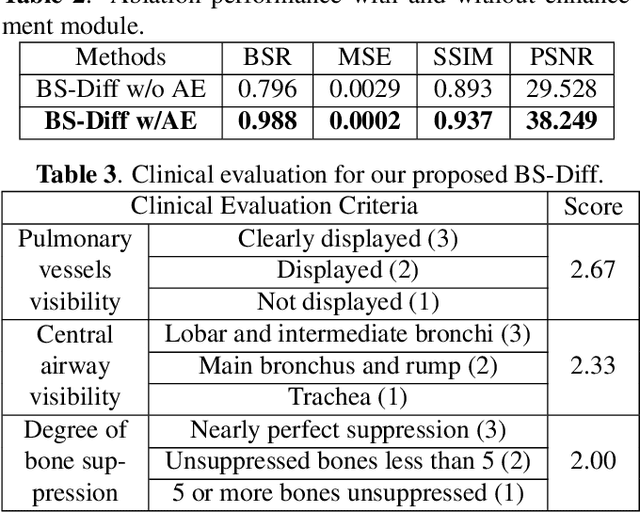
Abstract:Chest X-rays (CXRs) are commonly utilized as a low-dose modality for lung screening. Nonetheless, the efficacy of CXRs is somewhat impeded, given that approximately 75% of the lung area overlaps with bone, which in turn hampers the detection and diagnosis of diseases. As a remedial measure, bone suppression techniques have been introduced. The current dual-energy subtraction imaging technique in the clinic requires costly equipment and subjects being exposed to high radiation. To circumvent these issues, deep learning-based image generation algorithms have been proposed. However, existing methods fall short in terms of producing high-quality images and capturing texture details, particularly with pulmonary vessels. To address these issues, this paper proposes a new bone suppression framework, termed BS-Diff, that comprises a conditional diffusion model equipped with a U-Net architecture and a simple enhancement module to incorporate an autoencoder. Our proposed network cannot only generate soft tissue images with a high bone suppression rate but also possesses the capability to capture fine image details. Additionally, we compiled the largest dataset since 2010, including data from 120 patients with high-definition, high-resolution paired CXRs and soft tissue images collected by our affiliated hospital. Extensive experiments, comparative analyses, ablation studies, and clinical evaluations indicate that the proposed BS-Diff outperforms several bone-suppression models across multiple metrics.
View-Disentangled Transformer for Brain Lesion Detection
Sep 20, 2022



Abstract:Deep neural networks (DNNs) have been widely adopted in brain lesion detection and segmentation. However, locating small lesions in 2D MRI slices is challenging, and requires to balance between the granularity of 3D context aggregation and the computational complexity. In this paper, we propose a novel view-disentangled transformer to enhance the extraction of MRI features for more accurate tumour detection. First, the proposed transformer harvests long-range correlation among different positions in a 3D brain scan. Second, the transformer models a stack of slice features as multiple 2D views and enhance these features view-by-view, which approximately achieves the 3D correlation computing in an efficient way. Third, we deploy the proposed transformer module in a transformer backbone, which can effectively detect the 2D regions surrounding brain lesions. The experimental results show that our proposed view-disentangled transformer performs well for brain lesion detection on a challenging brain MRI dataset.
Learning to Prove Trigonometric Identities
Jul 14, 2022Abstract:Automatic theorem proving with deep learning methods has attracted attentions recently. In this paper, we construct an automatic proof system for trigonometric identities. We define the normalized form of trigonometric identities, design a set of rules for the proof and put forward a method which can generate theoretically infinite trigonometric identities. Our goal is not only to complete the proof, but to complete the proof in as few steps as possible. For this reason, we design a model to learn proof data generated by random BFS (rBFS), and it is proved theoretically and experimentally that the model can outperform rBFS after a simple imitation learning. After further improvement through reinforcement learning, we get AutoTrig, which can give proof steps for identities in almost as short steps as BFS (theoretically shortest method), with a time cost of only one-thousandth. In addition, AutoTrig also beats Sympy, Matlab and human in the synthetic dataset, and performs well in many generalization tasks.
Mixed Noise Removal with Pareto Prior
Aug 27, 2020



Abstract:Denoising images contaminated by the mixture of additive white Gaussian noise (AWGN) and impulse noise (IN) is an essential but challenging problem. The presence of impulsive disturbances inevitably affects the distribution of noises and thus largely degrades the performance of traditional AWGN denoisers. Existing methods target to compensate the effects of IN by introducing a weighting matrix, which, however, is lack of proper priori and thus hard to be accurately estimated. To address this problem, we exploit the Pareto distribution as the priori of the weighting matrix, based on which an accurate and robust weight estimator is proposed for mixed noise removal. Particularly, a relatively small portion of pixels are assumed to be contaminated with IN, which should have weights with small values and then be penalized out. This phenomenon can be properly described by the Pareto distribution of type 1. Therefore, armed with the Pareto distribution, we formulate the problem of mixed noise removal in the Bayesian framework, where nonlocal self-similarity priori is further exploited by adopting nonlocal low rank approximation. Compared to existing methods, the proposed method can estimate the weighting matrix adaptively, accurately, and robust for different level of noises, thus can boost the denoising performance. Experimental results on widely used image datasets demonstrate the superiority of our proposed method to the state-of-the-arts.
Learning Cluster Structured Sparsity by Reweighting
Oct 11, 2019

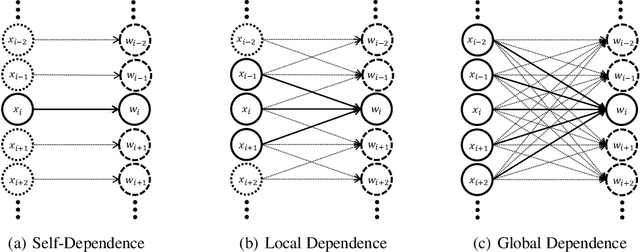

Abstract:Recently, the paradigm of unfolding iterative algorithms into finite-length feed-forward neural networks has achieved a great success in the area of sparse recovery. Benefit from available training data, the learned networks have achieved state-of-the-art performance in respect of both speed and accuracy. However, the structure behind sparsity, imposing constraint on the support of sparse signals, is often an essential prior knowledge but seldom considered in the existing networks. In this paper, we aim at bridging this gap. Specifically, exploiting the iterative reweighted $\ell_1$ minimization (IRL1) algorithm, we propose to learn the cluster structured sparsity (CSS) by rewegihting adaptively. In particular, we first unfold the Reweighted Iterative Shrinkage Algorithm (RwISTA) into an end-to-end trainable deep architecture termed as RW-LISTA. Then instead of the element-wise reweighting, the global and local reweighting manner are proposed for the cluster structured sparse learning. Numerical experiments further show the superiority of our algorithm against both classical algorithms and learning-based networks on different tasks.
CRNet: Image Super-Resolution Using A Convolutional Sparse Coding Inspired Network
Aug 03, 2019

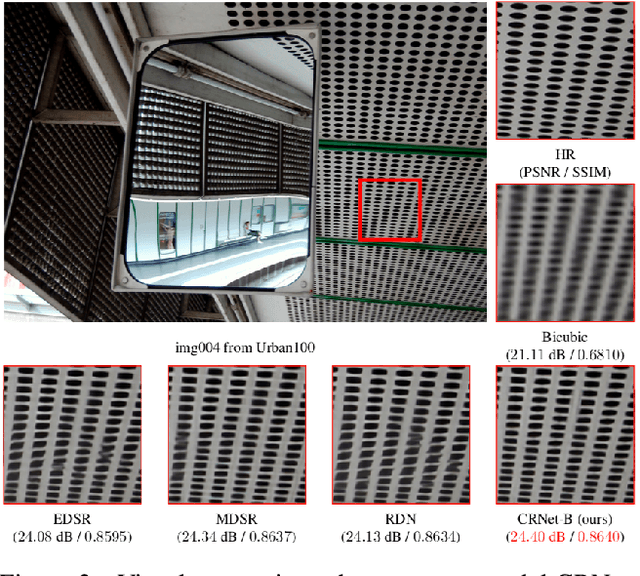

Abstract:Convolutional Sparse Coding (CSC) has been attracting more and more attention in recent years, for making full use of image global correlation to improve performance on various computer vision applications. However, very few studies focus on solving CSC based image Super-Resolution (SR) problem. As a consequence, there is no significant progress in this area over a period of time. In this paper, we exploit the natural connection between CSC and Convolutional Neural Networks (CNN) to address CSC based image SR. Specifically, Convolutional Iterative Soft Thresholding Algorithm (CISTA) is introduced to solve CSC problem and it can be implemented using CNN architectures. Then we develop a novel CSC based SR framework analogy to the traditional SC based SR methods. Two models inspired by this framework are proposed for pre-/post-upsampling SR, respectively. Compared with recent state-of-the-art SR methods, both of our proposed models show superior performance in terms of both quantitative and qualitative measurements.
 Add to Chrome
Add to Chrome Add to Firefox
Add to Firefox Add to Edge
Add to Edge